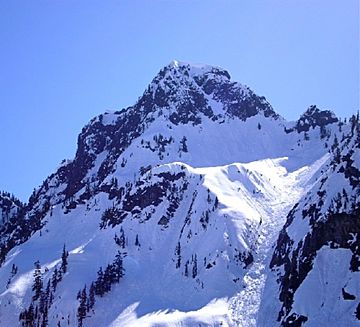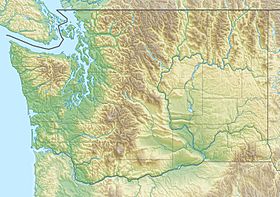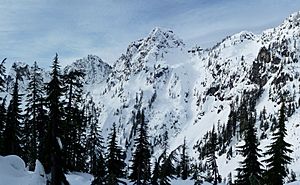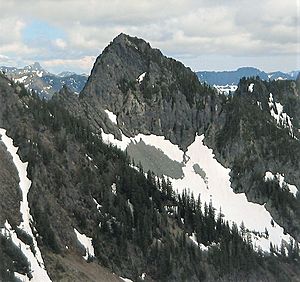Bryant Peak facts for kids
Quick facts for kids Bryant Peak |
|
|---|---|

Bryant Peak, east aspect
|
|
| Highest point | |
| Elevation | 5,801 ft (1,768 m) |
| Prominence | 321 ft (98 m) |
| Isolation | 0.65 mi (1.05 km) |
| Parent peak | Chair Peak (6,238 ft) |
| Geography | |
| Location | King County, Washington state, U.S. |
| Parent range | Cascade Range |
| Topo map | USGS Snoqualmie Pass |
| Type of rock | Andesite |
| Climbing | |
| First ascent | 1926 by Anderson, Best, Maxwell, Shorrock, West, Wunderling |
| Easiest route | Scrambling |
Bryant Peak is a mountain in King County, Washington state. It stands at 5,801 feet (1,768 meters) tall. This peak is part of the Cascade Range and is found within the Alpine Lakes Wilderness.
Bryant Peak is located northwest of Snoqualmie Pass. It is also near the Alpental ski area. The land around the peak is managed by the Mount Baker-Snoqualmie National Forest. South of the peak is Snow Lake, a popular spot for hikers. The closest taller mountain is Chair Peak, which is about 0.65 miles (1.05 km) away.
The mountain was first called Hemlock Peak. In 1925, it was renamed Bryant Peak. This was done to honor Sidney V. Bryant. He was a member of The Mountaineers club. He was the first person to climb Kaleetan Peak in 1914. Rain and melted snow from Bryant Peak flow into streams that lead to the Snoqualmie River.
What's the Weather Like on Bryant Peak?
Bryant Peak is in a region with a "marine west coast climate." This means it gets a lot of moisture from the ocean. Most weather systems start over the Pacific Ocean. They then travel northeast towards the Cascade Mountains.
When these weather systems reach the mountains, they are forced to rise. As they go higher, they drop their moisture. This creates a lot of rain or snowfall on the western side of the Cascades. Because of the ocean's influence, the snow is often wet and heavy. This can lead to a high risk of avalanches.
During winter, the weather is usually cloudy. However, in summer, high-pressure systems over the Pacific Ocean bring clear skies. The best months to visit or climb Bryant Peak are from July through September. This is when the weather is usually the most pleasant.
How Was Bryant Peak Formed?
The Alpine Lakes Wilderness has very rugged land. It features sharp peaks, deep valleys carved by glaciers, and tall granite walls. There are also more than 700 mountain lakes in this area.
The Cascade Range formed over millions of years. This process began in the late Eocene Epoch. The North American Plate is slowly moving over the Pacific Plate. This movement caused many volcanic eruptions. Also, small pieces of the Earth's crust, called terranes, helped form the North Cascades. This happened about 50 million years ago.
During the Pleistocene period, which started over two million years ago, glaciers played a big role. These huge ice sheets moved forward and backward many times. As they moved, they scraped away the land. They left behind piles of rock and debris. The last glaciers in the Alpine Lakes area started to melt about 14,000 years ago. They had moved north of the Canada–US border by 10,000 years ago.
The "U"-shaped valleys you see today were carved by these glaciers. The mountains became tall and the valleys deep because of two main things. These were the uplifting of the land and faulting, combined with the work of glaciers.





